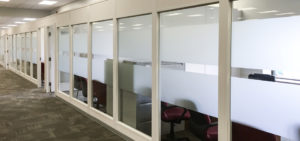Offices are an integral part of any company. The biggest difference is how a company chooses to lay it out. Employees have their preferences, and each layout has their own pros and cons. Read more to find out what layout you should use for your next office after your move with us!
 Traditional Office Layout
Traditional Office Layout
This is the most ideal layout, since every employee would have their own room and privacy. As nice as it would be to provide employees with this, it is also the most expensive option and lease optimized in terms of space. Styles like this are usually reserved for larger enterprises with a floor for their
executives.
Cubicle Office Layout

The layout everyone associates offices with, cubicles are the most cost effective way to provide some level of privacy while maximizing cost and space. Each cube is typically shared with someone else, but it provides a lot of storage options. While sound will be able to get in or out of the space, it does provide a sense of your own space compared to other more affordable options.
Low Partition Office Layout
 Similar to a cubicle, this office layout is even more cost effective with it’s low partitions separating the space. However, the partitions are typically see through or frosted and thus not as liked due to it providing less privacy than a cubicle.
Similar to a cubicle, this office layout is even more cost effective with it’s low partitions separating the space. However, the partitions are typically see through or frosted and thus not as liked due to it providing less privacy than a cubicle.
Open Floor Office Layout

The open floor office layout is one of the most disliked styles for employees due to its complete lack of privacy. This style is best used in tandem with other styles in a hybrid environment. This layout also seemed to reach fad levels in the 2010’s, with offices around the world converting to this type of format. There have been many studies reviewing the impact on employees and as noted it was highly disliked, and even deemed unproductive in some scenarios.
What is the future of your business layout and are you prepared for the next evolution of the workplace? Reach out to Olympia Office Movers today for a free consultation and take advantage of our 30 years of experience and endless capabilities.
